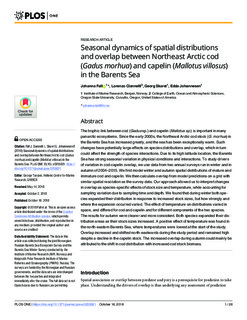| dc.description.abstract | The trophic link between cod (Gadus sp.) and capelin (Mallotus sp.) is important in many panarctic ecosystems. Since the early 2000s, the Northeast Arctic cod stock (G. morhua) in the Barents Sea has increased greatly, and the sea has been exceptionally warm. Such changes have potentially large effects on species distributions and overlap, which in turn could affect the strength of species interactions. Due to its high latitude location, the Barents Sea has strong seasonal variation in physical conditions and interactions. To study drivers of variation in cod-capelin overlap, we use data from two annual surveys run in winter and in autumn of 2004–2015. We first model winter and autumn spatial distributions of mature and immature cod and capelin. We then calculate overlap from model predictions on a grid with similar spatial resolution as the survey data. Our approach allowed us to interpret changes in overlap as species-specific effects of stock size and temperature, while accounting for sampling variation due to sampling time and depth. We found that during winter both species expanded their distribution in response to increased stock sizes, but how strongly and where the expansion occurred varied. The effect of temperature on distributions varied in space, and differed for cod and capelin and for different components of the two species. The results for autumn were clearer and more consistent. Both species expanded their distribution areas as their stock sizes increased. A positive effect of temperature was found in the north-eastern Barents Sea, where temperatures were lowest at the start of the study. Overlap increased and shifted north-eastwards during the study period and remained high despite a decline in the capelin stock. The increased overlap during autumn could mainly be attributed to the shift in cod distribution with increased cod stock biomass. | nb_NO |
